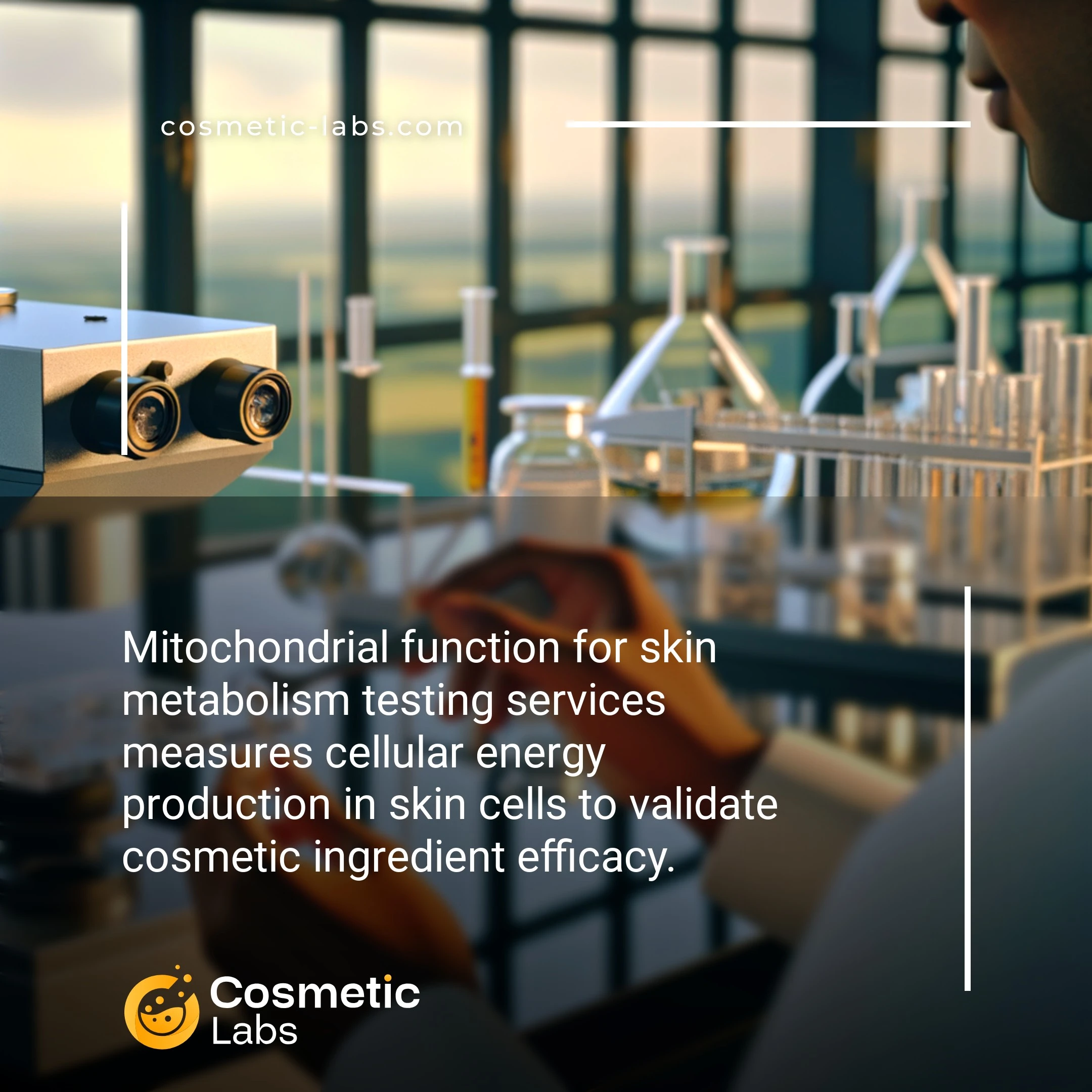Mitochondrial Function Testing for Skin Metabolism Analysis

What is Mitochondrial function?
Mitochondrial function testing for skin metabolism measures how well skin cells produce energy at the cellular level, focusing on ATP synthesis and oxygen consumption rates in keratinocytes and fibroblasts. Labs use seahorse bioanalyzer technology to track real-time metabolic changes when your ingredients interact with skin cells. This testing reveals whether your anti-aging formulations actually boost cellular energy production or if they’re disrupting normal mitochondrial respiration—data that’s becoming increasingly important for substantiating energy-boosting claims in premium skincare products.
Why do you need this service?
Cosmetic labs use mitochondrial function testing to validate anti-aging ingredients before you launch products, measuring cellular energy production in skin models to prove your serums actually boost metabolism. Teams also apply these protocols to demonstrate ingredient efficacy in regulatory submissions, providing the scientific data needed to support marketing claims about cellular renewal and skin vitality.
Who provides Mitochondrial function services?
All cosmetic labs providing Mitochondrial function services
There is no company providing these services at the moment.
Mitochondrial Function Testing for Skin Metabolism Analysis
Mitochondrial function testing measures how well your cosmetic ingredients boost cellular energy production in skin cells. Labs use specialized assays to evaluate ATP synthesis, oxygen consumption, and metabolic activity – providing concrete data on how your formulations affect skin’s energy pathways.
ATP Production and Cellular Energy Measurement
Labs measure ATP synthesis rates using luminescence-based assays that track energy production in cultured skin cells. This testing reveals how ingredients like coenzyme Q10, niacinamide, or peptides influence cellular powerhouses. Testing protocols typically run 24-72 hours with multiple concentration points.
Key measurements include:
- Baseline ATP levels in treated vs. untreated cells
- Mitochondrial membrane potential changes
- Oxygen consumption rates during energy production
Metabolic Activity and Respiratory Chain Analysis
Respiratory chain testing evaluates how ingredients affect the electron transport system that drives cellular energy. Labs use seahorse analyzers and fluorescent probes to measure real-time metabolic changes. This data helps validate anti-aging claims and energy-boosting product benefits.
Testing includes metabolic stress tests that simulate aging conditions. Labs can also measure mitochondrial biogenesis markers to show how ingredients promote new mitochondria formation. Results support efficacy claims for energy-enhancing skincare products.
Connect with specialized labs on our platform to design mitochondrial function studies that validate your product’s cellular energy benefits.
Applications of Mitochondrial Function Testing for Skin Metabolism
Cosmetic labs use mitochondrial function testing for skin metabolism to validate anti-aging claims and develop energy-boosting formulations that target cellular powerhouses.
Anti-Aging Product Development
Labs measure ATP production rates and oxygen consumption in skin cells to prove that ingredients enhance mitochondrial efficiency. Testing protocols track cellular respiration changes over 24-48 hour periods using specialized respirometry equipment.
Brands developing serums with CoQ10, nicotinamide, or peptides rely on these assays to demonstrate measurable improvements in cellular energy production. Results typically show 15-30% increases in ATP synthesis when effective ingredients are tested at optimal concentrations.
| Mitochondrial Parameter | Testing Method | Typical Results Timeline | Application |
|---|---|---|---|
| ATP Production | Luminescence Assay | 2-4 hours | Energy booster claims |
| Oxygen Consumption | Seahorse Analyzer | 24-48 hours | Metabolic enhancement |
| Membrane Potential | Fluorescent Probes | 1-6 hours | Cellular vitality |
| Antioxidant Capacity | ROS Detection | 4-12 hours | Protection claims |
Ingredient Screening and Optimization
Testing services evaluate raw materials for their ability to protect mitochondria from oxidative stress and improve electron transport chain function. Labs screen botanical extracts, synthetic compounds, and novel actives using standardized protocols.
This approach helps formulators identify the most effective ingredients before full product development begins. Screening typically reduces development time by 30-40% while ensuring only proven mitochondrial enhancers make it into final formulations.
Ready to validate your anti-aging claims with mitochondrial testing? Connect with specialized cosmetic labs on our platform to discuss your specific testing requirements and timeline.
